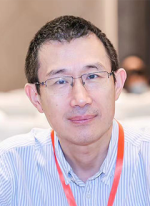Editor-in-Chief

Yi-Xiang Wang, M.Med., Ph.D.
Email: yixiang_wang@cuhk.edu.hk.
Dr. Yi-Xiang Wang read medicine, trained in diagnostic and interventional radiology, as well as obtained a research doctorate (PhD, Shanghai Med U) in China. He did post-doctoral fellowships in Sheffield Medical School, UK, and Rotterdam School of Medicine (Erasmus MC), the Netherlands. Dr. Wang was with AstraZeneca Pharmaceuticals R&D (UK) as a senior scientist/associate team leader during 2001-2006. He joined the Faculty of Medicine at the Chinese University of Hong Kong in late 2006, where he is currently a professor. He is also an adjunct Professor of Jinan University, Guangzhou, China. Dr Wang is the Editor-in-Chief of Quant Imaging Med Surg journal. In recent years, his research has mainly focused on three directions: (1) new techniques of liver magnetic resonance imaging; (2) osteoporotic fracture, bone mineral density measurement and spine degenerative diseases; (3) epidemiology of cerebral aneurysm rupture. He pioneered a number of liver MRI techniques such as T1rho, CEST, DDVD (diffusion derived vessel density), 3-dimenional analysis of IVIM parameters. His work on epidemiology of spine degeneration including disc space narrowing, spondylolisthesis, osteoporotic fracture, and bone mineral density provides reference standard for East Asians, and also deepened the understanding of pathophysiology of spine degeneration. He has published >300 papers, and his works have been cited for > 14,000 times, with H-index > 58 (both based on Web of Science, Google citation: 21,000 times, Google H-index > 68. updated Nov 2023).
Recent publications of interest:
- Wáng YXJ, Aparisi Gómez MP, Ruiz Santiago F, Bazzocchi A. The relevance of T2 relaxation time in interpreting MRI apparent diffusion coefficient (ADC) map for musculoskeletal structures. Quant Imaging Med Surg 2023. doi: 10.21037/qims-23-1392
- Wáng YXJ, Ma FZ. A tri-phasic relationship between T2 relaxation time and magnetic resonance imaging (MRI)-derived apparent diffusion coefficient (ADC). Quant Imaging Med Surg 2023. doi: 10.21037/qims- 23-1342
- Wáng YXJ, Griffith JF, Blake GM, Diacinti D, Xiao BH, Yu W, Su Y, Jiang Y, Guglielmi G, Guermazi A, Kwok TCY. Revision of the 1994 World Health Organization T-score definition of osteoporosis for use in older East Asian women and men to reconcile it with their lifetime risk of fragility fracture. Skeletal Radiol. 2023 Oct 27. doi: 10.1007/s00256-023-04481-7.
- Wáng YXJ, Blake GM, Xiao BH, Guglielmi G, Su Y, Jiang Y, Guermazi A, Kwok TCY, Griffith JF. East Asians' T-scores for the diagnosis of osteoporosis should be calculated using ethnicity- and gender-specific BMD reference ranges: justifications. Skeletal Radiol. 2023 Aug 11. doi: 10.1007/s00256-023-04423-3.
- Yu WL, Xiao BH, Ma FZ, Zheng CJ, Tang SN, Wáng YXJ. Underestimation of the spleen perfusion fraction by intravoxel incoherent motion MRI. NMR Biomed. 2023;36:e4987. doi: 10.1002/nbm.4987.
- Wáng YXJ. Schmorl's node of primarily developmental cause and Schmorl's node of primarily acquired cause: two related yet different entities. Quant Imaging Med Surg. 2023;13:4044-4049. doi: 10.21037/qims-23-252.
- He J, Chen C, Xu L, Xiao B, Chen Z, Wen T, Wáng YXJ, Liu P. Diffusion-Derived Vessel Density Computed From a Simplified Intravoxel Incoherent Motion Imaging Protocol in Pregnancies Complicated by Early Preeclampsia: A Novel Biomarker of Placental Dysfunction. Hypertension. 2023;80:1658-1667. doi: 10.1161/HYPERTENSIONAHA.122.20311.
- Wáng YXJ, Leung JCS, Lam PMS, Kwok TCY. Conversion of osteoporotic-like vertebral fracture severity score to osteoporosis T-score equivalent status: A framework study for older Chinese men. Osteoporos Sarcopenia. 2023;9(:14-21. doi: 10.1016/j.afos.2023.03.004.
- Wáng YXJ, Diacinti D, Leung JCS, Iannacone A, Kripa E, Kwok TCY, Diacinti D. Conversion of osteoporotic vertebral fracture severity score to osteoporosis T-score equivalent status: a framework and a comparative study of Hong Kong Chinese and Rome Caucasian older women. Arch Osteoporos. 2022;18:1. doi: 10.1007/s11657-022-01178-7.
